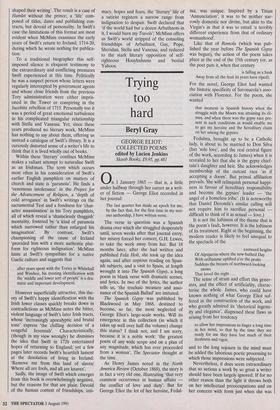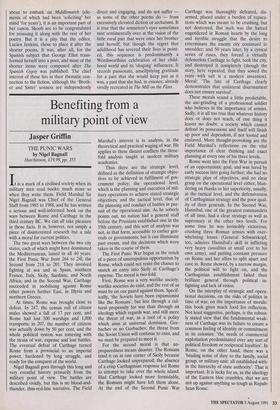Trying too hard
Beryl Gray
GEORGE ELIOT: COLLECTED POEMS edited by Lucien Jenkins Skoob Books, f9.95, pp.481 on 1 January 1865 — that is, a little under halfway through her career as a writ- er of fiction — George Eliot recorded in her journal:
The last quarter has made an epoch for me, by the fact that, for the first time in my seri- ous authorship, I have written verse.
The verse in question was a Spanish drama over which she struggled desperately until, seven weeks after that journal entry, her misery forced her consort, G.H. Lewes, to take the work away from her. But 18 months later, after she had written and published Felix Holt, she took up the idea again, and after copious reading on Span- ish subjects, and a visit to Spain, at length wrought it into The Spanish Gypsy, a long poem in blank verse with dramatic scenes, and lyrics. In two of the lyrics, the author tells us, 'the trochaic measure and asso- nance of the Spanish Ballad' are imitated.
The Spanish Gypsy was published by Blackwood in May 1868, destined to become, so far, the most neglected of George Eliot's large-scale works. Will its emergence in this collection (in which it takes up well over half the volume) change this status? I think not, and I am sorry, because it is a noble work: 'the greatest poem of any wide scope and on a plan of any magnitude, which has ever proceeded from a woman', The Spectator thought at the time.
As Henry James noted in the North America Review (October 1868), the story is in fact a very old one, illustrating 'that very common occurrence in human affairs the conflict of love and duty'. But for George Eliot the lot of her heroine, Fedal- ma, was unique. Inspired by a Titian `Annunciation', it was to be neither nar- rowly domestic nor divine, but akin to the Virgin's in that it was to entail `a terribly different experience from that of ordinary womanhood'.
Like that of Romola (which was pub- lished the year before The Spanish Gypsy was begun), the action of the poem takes place at the end of the 15th century (or, as the poet puts it, when that century
is falling as a husk Away from all the fruit its years have riped).
For the novel, George Eliot had wanted the historic specificity of Savonarola's asso- ciation with Florence. For the poem, she wanted
that moment in Spanish history when the struggle with the Moors was attaining its cli- max, and when there was the gypsy race pre- sent in such conditions as would enable me to get my heroine and the hereditary claim on her among the gypsies.
Fedalma, brought up to be a Catholic lady, is about to be married to Don Silva (her 'sole love', and the real central figure of the work, according to James) when it is revealed to her that she is the gypsy chief- tain's daughter and heir. She acknowledges membership of the outcast race 'as if accepting a doom'. But primal affiliation prevails. She will relinquish personal happi- ness in favour of hereditary responsibility and become the gypsies' leader — 'the angel of a homeless tribe'. (It is noteworthy that Daniel Deronda's similar calling will not require him to sacrifice personal difficult to think of it as sexual — love.) It is not the loftiness of the theme that is the poem's fault, however. It is the loftiness of its treatment. Right at the beginning, the modern reader is likely to feel unequal to the spectacle of the
eastward heights Of Alpujarras where the new-bathed Day With oriflamme uplifted o'er the peaks Saddens the breasts of northward-looking snows That loved the night . .
The sense of strain and effort this gener- ates, and the effect of artificiality, charac- terise the whole. James, who could have known nothing of what George Eliot suf- fered in the construction of the work, and who greatly admired its 'rhetorical ingenu- ity and elegance', diagnosed these flaws as arising from her tendency
to allow her impressions to linger a long time in her mind, so that by the time they are ready for use they have lost much of their freshness and vigor;
and to the long sojourn in the mind must be added the laborious poetic processing to which those impressions were subjected.
Nevertheless, it does seem extraordinary that so serious a work by so great a writer should have been largely ignored. If for no other reason than the light it throws both on her intellectual preoccupations and on her concern with form just when she was about to embark on Middlemarch (ele- ments of which had been 'soliciting' her mind 'for years'), it is an important part of her canon. Skoob are to be congratulated for reissuing it along with the rest of her poetry. But it is a pity that the editor, Lucien Jenkins, chose to place it after the shorter poems. It was, after all, for the Spanish subject that George Eliot trans- formed herself into a poet, and most of the shorter items were composed after The Spanish Gypsy was published. The chief interest of these lies in their thematic con- nection to the fiction, although the 'Broth- er and Sister' sonnets are independently direct and engaging, and do not suffer as some of the other poems do — from excessively elevated diction or archaisms. It is true that the sonneteer's eyes sometimes mist sentimentally over at the vision of the little rural pair that were once her brother and herself; but though the regret that adulthood has severed their lives is point- ed, this sequence is predominantly a Wordsworthian celebration of her child- hood world and its 'shaping' influences. It records passionate, unselfpitying gratitude for a past that she would keep just as it was, a past that she had, in essence, already vividly recreated in The Mill on the Floss.



















































 Previous page
Previous page